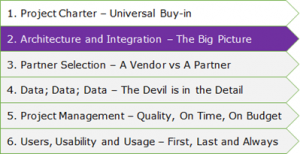How to successfully deliver your CRM project with Clarity, Simplicity and Certainty
This is the 2nd in a series of 6 articles looking at how to successfully deliver your CRM project. The full series contains:

The purpose of the Architecture is to help teams develop the technical capability on time and on budget whilst ensuring it solves the problem for which it was designed. The Architecture will build on the very high-level view purported in the Charter and will contain:
- Concepts – A conceptual view of the stack and its moving parts for communication and context
- Option Analysis – Platforms, Languages and Tools in light of the functional and non-functional requirements.
- High Level Design – Features, phases and solution requirements at a Function level
- Detailed Design – More definition around areas of complexity
- Non-functional requirements including – Security, Performance, Maintainability, Scalability, Reliability, Usability and Risk
The expected outcome is that both the business and technical requirements have been incorporated into a Solution. Specific technologies may be selected, short listed or used as examples as the Architecture develops over time.

The Architecture is neither a Process Diagram nor the detailed User Requirements, which will be developed in the next phase of the project.
3 x Critical Success Factors
These are CSFs for the Architecture, not the Project:
- Match the Solution to the Business Environment
This is important in all major technology solutions but even more so with CRM deployments due to its role in supporting all customer facing interactions and integrating to all other teams. The Architecture must take a strategic view of the specific functional requirements and then the significance and importance of potential reliance’s on and impacts to other teams and their processes
- Desire vs Reality
The simple approach of Why, What and How (Before When & Who) will assist in addressing this challenge:
- Why: The justification of the need for the whole solution or any of its parts supported by the Business Case ROI should always drive decisions around compromise and prioritisation
- What: The definition of what needs to be included in the project will create the scope
- How: The way in which it will be delivered is where many CRM projects come unstuck as simple functions require complex technical delivery
Issues arise from such things as a desire to use a single platform, satisfying everyone’s needs (refer to CSF 1), the use or not of integrations tools (Refer to CSF 3), loading all, selected or summary data. Compromise doesn’t normally provide a satisfactory solution, but prioritisation will.
- Knowing Your Stress Points
Later in the series we will look specifically at Data but at an Architectural level the flow of data due to the integration between systems and processes will create stress points that need meticulous design and then development
Intersections are as dangerous in technology projects as they are on the road; Approach carefully, look both ways and don’t assume anything. Building the individual parts is the easy bit, making them flow, sync, work in reverse and acknowledge who is the master are detailed challenges. Before we even get onto Automation and Consolidation.
2 x Reasons how this is Unique to Manufacturing
Sometimes it is subtle variances that make the difference in approach and each industry has its own idiosyncrasies:
- ERP Integration – Model 1 indicates that the selection of Operations systems are outside the scope of a CRM project. However the integration with those systems is critical to the success of the Project. Two simple examples:
- Credit Facility – A Salesperson in a conversation with a customer needs to know the Credit status of that customer. Automation will assist but finance needs to own that process, as it must with new customers
- Sales Outcomes – Both Sales and Marketing need to know the status of an order, the value of the order and when it is successfully delivered. Operations and ERP will manage the data that shows this and provide it to other systems
- Manufacturing as a process – Manufacturing and B2B Sales and Marketing are much more diverse than B2C or Services. The potential issues around supply chain and the requirement for accurate forecasting demands the timely and cohesive transfer of information between both environments. Integration is key.
In Summary
Clarity – The Architecture, along with the complex view of integrations, will provide a clear view of how the business and technical aspects of the projects will be satisfied through the deliverables
Simplicity – The Architecture is a ‘Big Picture’ view of the Project whereby the simple, or simplest, solution can be designed that provides the best technical solution and the greatest business benefits.
Certainty – The Architecture creates the vehicle whereby conflicts between Why, What and How can be addressed and fully informed decisions can be made around how to prioritise, not compromise, the use of project resources to develop the required technical capability on time, on budget.
- Contact Scott Fuller for further information: 027 596 9053 or email scott@xception.co.nz



